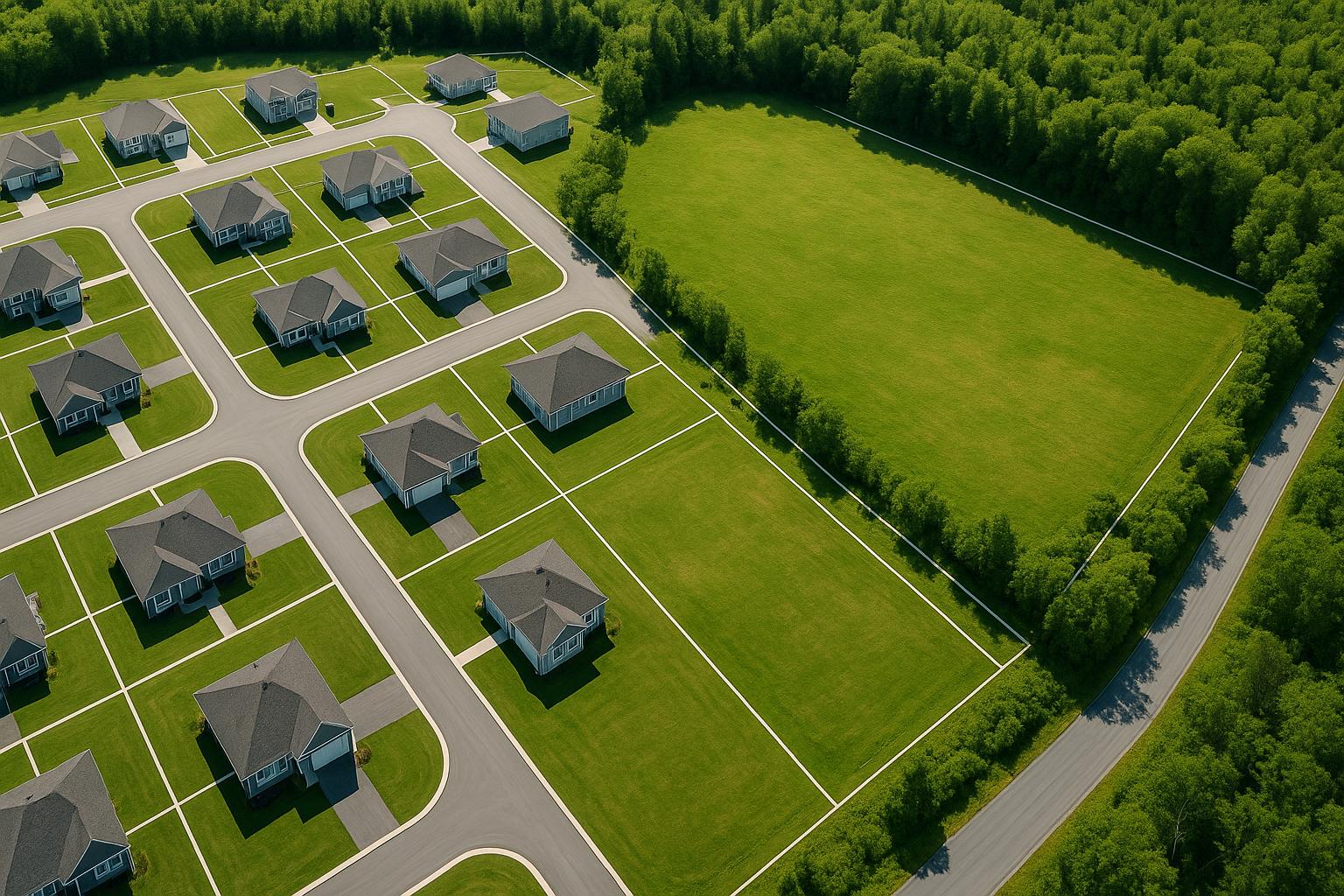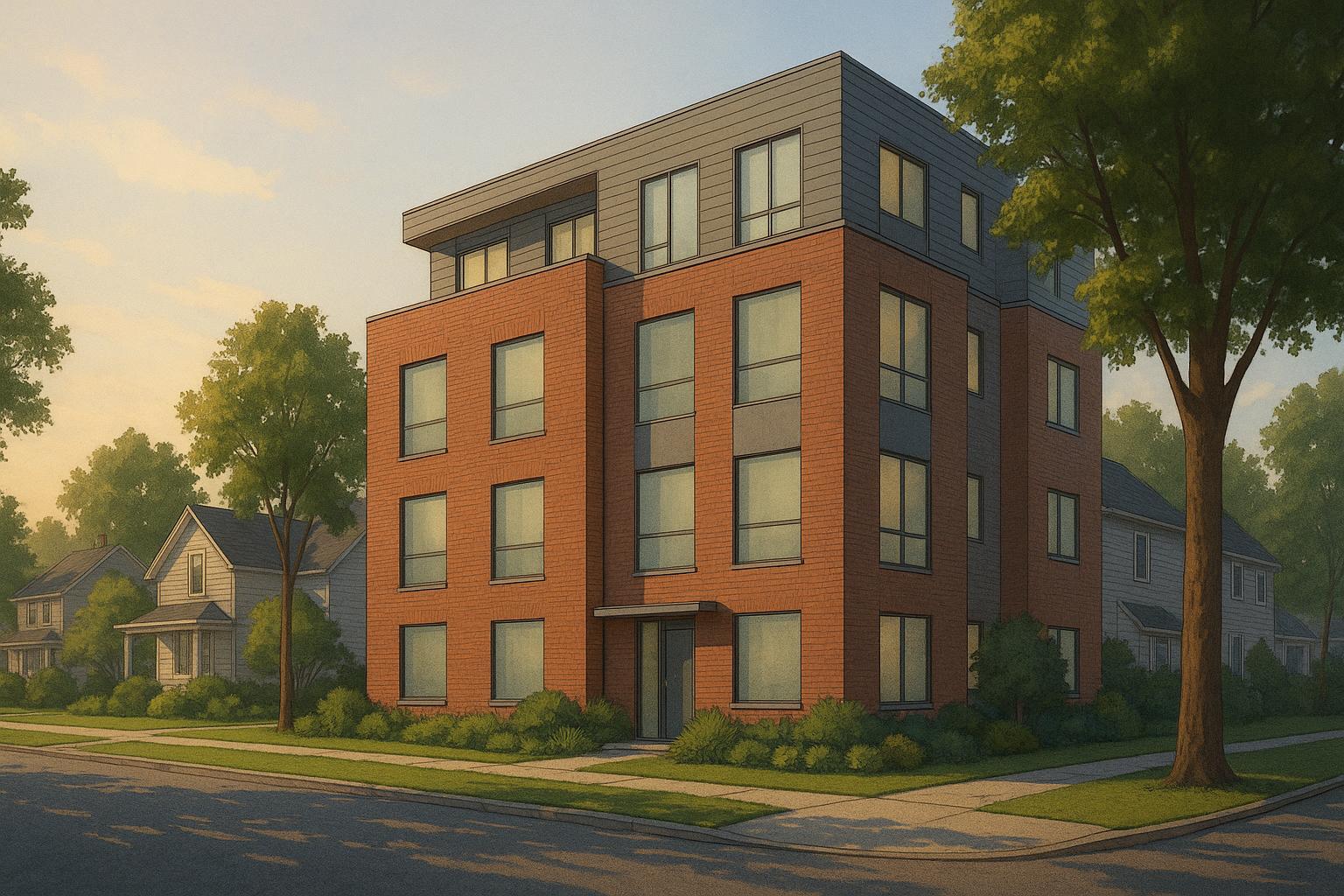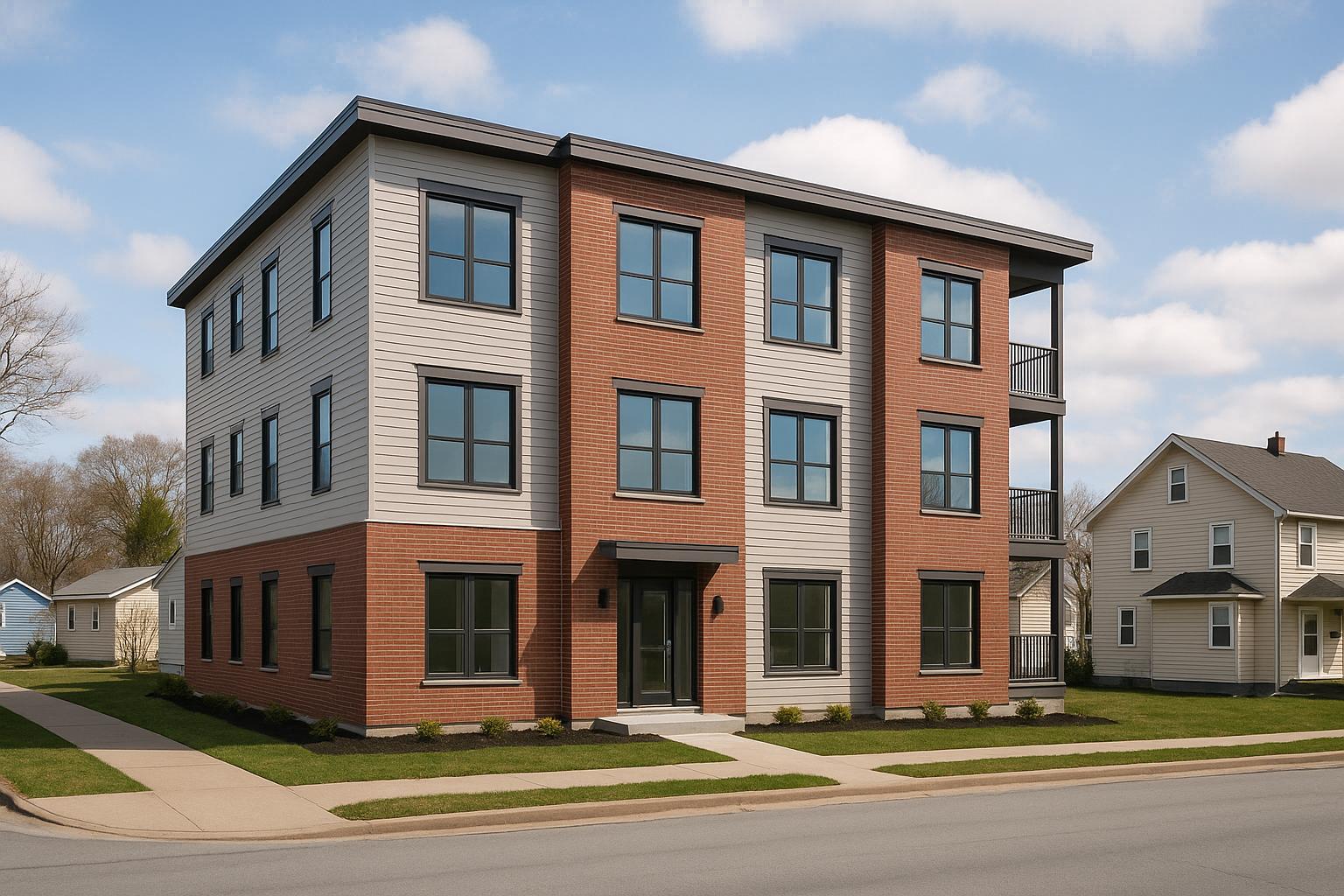Constructing 4-24 unit apartments in Halifax in 2025 offers a promising opportunity due to strong rental demand. However, the process is often slowed by lengthy approvals, service upgrades, and coordination issues. Here's the key takeaways to avoid delays and maximize ROI:
- Approval timelines: Planning applications can take 10–12 months, often longer than construction itself.
- Utility connections: Early coordination with Halifax Water, Nova Scotia Power, and other providers is critical to avoid setbacks.
- Service upgrades: Projects exceeding current infrastructure capacity may require costly upgrades; assess this early.
- Construction approach: Integrated construction reduces delays, offering fixed timelines and cost savings.
- Best locations: High-demand streets like Robie, Gottingen, and Portland offer strong rental potential.
To succeed, focus on pre-planning, streamlined approvals, and choosing high-demand areas with solid rental prospects. Integrated construction ensures faster completion and higher returns.
Nova Scotia Designates 9 Areas in Halifax For Accelerated Housing Development
Utility Connections for Small Apartment Buildings
Getting utility connections sorted out early is crucial to keeping your project on schedule and avoiding unnecessary costs. In Halifax, dealing with multiple utility providers and permits is a key part of the process. Here’s a closer look at how to handle connections, timelines, and approvals.
Required Utilities and Connection Process
For water, wastewater, and stormwater services, you'll need to work with Halifax Water through the Halifax Building Permit Process. A "Preliminary servicing schematic", prepared by a Professional Engineer in line with Halifax Regional Water Commission Design and Construction Specifications, is required for new service connections. Halifax Water typically processes these applications within five business days once all documents are submitted [3][4].
Electrical connections must comply with the National Energy Code of Canada for Buildings 2017 (NECB), which focuses on energy efficiency [2]. For natural gas, you'll coordinate with Eastward Energy (formerly Heritage Gas) to confirm service availability and schedule installation during construction [2].
Don’t forget about internet and telecommunications - these providers often have specific installation requirements, and delays in setting these up can push back tenant move-ins. If your project is in an area with a combined sewer system, you’ll need to plan carefully for the excavation and connection of sanitary and storm drains, as these processes can affect your construction schedule [2].
Connection Timelines and Approval Steps
Planning applications in Halifax generally take 10–12 months to process, though this can vary depending on the complexity of the project and the level of community involvement [3]. While Halifax Water’s five-business-day turnaround is quick, it only begins after all required documents are submitted and approved [4].
As CMHC economist Kelvin Ndoro pointed out:
"Developers highlighted cases where obtaining the initial approval for the projects took longer than building the units, making permits a significant drag on housing supply." [1]
Fire safety inspections are another hurdle. These inspections are required under the Nova Scotia Fire Safety Act for residential buildings with more than three units. They ensure that fire prevention systems and service rooms meet regulatory standards. Any issues found during these inspections can delay utility activation [2].
Coordination challenges can also stretch timelines. Traditional construction methods often involve separate contractors - plumbers, electricians, and site coordinators - working independently, which can add weeks or even months to the process. An integrated construction approach, where all trades collaborate as one team, can significantly streamline utility connections.
Finally, weather plays a big role. Harsh winter conditions can make underground utility installations difficult. Scheduling this work during milder seasons, like fall or spring, can help avoid weather-related delays. Integrated teams are often better equipped to handle these seasonal challenges through careful, coordinated planning.
Service Upgrades for Apartment Projects
Service upgrades can have a big impact on both the budget and timeline of your apartment project. Identifying whether your project will require these upgrades early in the process is key. By understanding the steps involved and preparing detailed plans, you can make these improvements more manageable.
When Service Upgrades Are Required
Service upgrades typically come into play when you’re installing new utility connections, modifying existing ones, or if your development’s increased demand exceeds the capacity of the current infrastructure. It’s crucial to determine early on if your project will trigger these requirements.
Start by contacting Halifax Water with your civic address. Use your Site Servicing Plan - which includes proposed connections and capacity calculations - to confirm whether upgrades will be necessary [5]. This plan should detail water, wastewater, and stormwater service connections, along with information about existing mains and other infrastructure like natural gas, power, and communication systems [5].
Capacity calculations often highlight the need for upgrades. For example, you may need to provide details on water meter sizing, fire flow requirements, and wastewater connection sizing. In some cases, a "Downstream Wastewater Calculation" will be required to evaluate the hydraulic capacity of the receiving mains and downstream system [5].
If Halifax Water’s hydraulic analysis finds that the existing Combined/Wastewater System lacks sufficient capacity, upgrades will be necessary. In such cases, it’s your responsibility to complete these upgrades to ensure the system can handle the increased demand [5].
Building code compliance can also trigger service upgrades. Projects like adding secondary suites, home additions, or significant renovations often require Building Permits. These permits involve reviewing mechanical, plumbing, and electrical systems to ensure they meet the Nova Scotia Building Code Regulations and Halifax Regional Municipality By-law B-201 Respecting the Building Code [5].
Taking these steps early in your planning phase can help you avoid surprises later in the construction process. Once you’ve identified the potential for upgrades, the next step is to assess their costs and explore any rebates that might be available.
Upgrade Costs and Available Rebates
Budgeting for service upgrades and permit fees - covering water, wastewater, electrical, and natural gas services - is essential from the start [5]. Water Permits are required for tasks like installing, altering, or relocating sewer and water equipment. Building Permits, meanwhile, ensure that all upgrades comply with current code requirements [5].
sbb-itb-16b8a48
How to Avoid Construction Delays
Imagine an 8-month project dragging on for 18 months. That’s the reality when poor coordination takes over. Missed deadlines don’t just cost time - they can rack up thousands of dollars in extra expenses and delay rental income. Let’s break down the main culprits behind construction delays and how an integrated approach can help keep your project on track.
Main Causes of Construction Delays
One of the biggest headaches in traditional apartment construction is the lack of coordination among independent professionals. Architects, engineers, general contractors, plumbers, electricians, and HVAC specialists often work on their own schedules. This creates a domino effect. For example, if an architect’s design later reveals structural flaws, the entire project grinds to a halt while revisions are made.
Permitting is another bottleneck. Building permits, water permits, and service upgrades are often handled one at a time rather than simultaneously, unnecessarily stretching timelines.
Material ordering mistakes add fuel to the fire. Contractors may order materials based on incomplete plans, only to find out later that they don’t match the project’s needs. This can lead to costly storage issues or, worse, weather damage to materials left exposed.
And speaking of weather, the longer a project drags on, the more it’s at the mercy of unpredictable conditions. In a place like Halifax, extending a project from 6 months to 12 or 18 months increases the risk of delays due to harsh winter weather.
Integrated Construction Benefits
Knowing what causes delays makes it easier to see why integrated construction is a game-changer. This approach brings all professionals - architects, engineers, contractors - under one roof, working as a cohesive team. The result? Fewer moving parts and fewer opportunities for things to go wrong.
With integrated construction, fixed timelines become a reality. For instance, Helio Urban Development offers a 6-month construction guarantee, with financial penalties of up to $1,000 per day for delays. That level of accountability isn’t possible when you’re juggling multiple contractors.
Coordinated scheduling replaces the guesswork. Integrated teams handle design, permits, and construction in tandem, avoiding the delays that come from piecemeal approvals. For example, utility approvals that might drag on in a traditional setup are streamlined in an integrated process.
Another major perk is single-point accountability. If delays happen, the integrated builder takes full responsibility and has a strong financial incentive to resolve issues quickly.
| Traditional Construction | Integrated Construction |
|---|---|
| 6+ separate contractors | One team, one contract |
| 12–18 month timelines | 6-month guaranteed completion |
| Cost-plus pricing (30–60% overruns) | Fixed-price contracts |
| Disjointed scheduling | Coordinated planning |
| Multiple warranties | Single warranty coverage |
| Sequential permit approvals | Simultaneous permit handling |
Integrated construction also improves quality control. Potential issues are caught during the design phase, not halfway through the build, reducing the need for expensive rework and saving valuable time.
The financial benefits are hard to ignore. Property owners save an average of $47,000 by cutting out inefficiencies. Plus, they start collecting rental income sooner. For a fourplex generating $8,800 a month, finishing 6 months earlier means $52,800 in additional revenue. Faster completion doesn’t just save money - it boosts your return on investment.
Best Halifax Streets for Small Apartments in 2025
When it comes to rental investments, location is everything. The street you choose can significantly impact rental income and property value. Halifax's growing rental market offers exciting opportunities for small apartment developments.
High-Demand Streets and Areas
Halifax’s Peninsula is a prime spot for rental properties, with streets like Young Street, Robie Street, and Quinpool Road standing out. These areas are close to major employers and universities, making them highly attractive to renters. For example, two-bedroom units here typically command rents between $1,950 and $2,100 per month, making small apartment projects a financially sound choice.
Robie Street is especially appealing for multi-unit developments. It boasts excellent transit options and is near Halifax Common and university campuses, making it a favourite for young professionals and students seeking modern, well-maintained apartments.
The North End is another area gaining traction for apartment construction. Streets like Gottingen and Agricola offer relatively affordable land while maintaining strong rental demand. Meanwhile, Barrington Street benefits from its proximity to local job hubs like the Halifax Shipyard, ensuring a steady flow of tenants.
Dartmouth also provides great value for developers. Streets such as Portland Street and Wyse Road combine lower land costs with the convenience of a direct ferry to downtown Halifax, attracting renters who prioritize both space and accessibility.
Neighbourhoods like Clayton Park and Fairview offer a balanced proposition. Lacewood Drive, for instance, provides easy access to shopping, schools, and major highways. While rental rates in these areas might be slightly lower than on the Peninsula, the lower overall costs can deliver solid returns for builders.
Tailoring your projects to the neighbourhood is key. Smaller units near universities are ideal for students and recent graduates, while family-friendly areas are better suited for two-bedroom apartments targeting young professionals and families.
Infrastructure Projects Affecting Development
Ongoing infrastructure projects are adding to the appeal of key rental areas. The Cogswell District redevelopment is a major downtown initiative aimed at improving connectivity and boosting the area's overall charm. Properties nearby are likely to benefit from better access and increased interest as the project progresses.
Traffic and pedestrian improvements are also transforming previously overlooked neighbourhoods. Upgrades on streets like Barrington and Hollis are extending the reach of major employment hubs into surrounding communities.
Transit enhancements are another game-changer. The planned Bus Rapid Transit system will improve links between Dartmouth and Halifax, making areas like Portland Street and Wyse Road even more attractive to renters as accessibility improves.
The Halifax Shipyard’s ongoing expansion is expected to drive rental demand in the North End, particularly near Barrington Street, as workers look for convenient housing options.
Active transportation upgrades, such as new bike lanes on University Avenue and South Park Street, are also drawing environmentally conscious renters to these areas. Improvements to utility infrastructure, like upgraded electrical and water systems, are reducing construction costs and making certain neighbourhoods even more appealing for new developments.
Keeping an eye on these infrastructure projects can help you time your construction to meet peak rental demand when your building is ready.
Building Small Apartments in Halifax: Next Steps
Constructing small apartments in Halifax requires careful coordination of utilities, services, and site planning. The difference between a seamless project and one plagued by delays often hinges on how well these elements are aligned from the outset.
Start with pre-application planning. Before submitting any applications, schedule meetings with planning staff, Halifax Water, and Nova Scotia Power. These early discussions can help flag potential issues - like zoning conflicts or limits on servicing capacity - before they escalate into costly setbacks [6]. Skipping this step can lead to unnecessary delays and added expenses. By addressing these concerns early, you set the groundwork for a smoother, more efficient process.
An integrated construction approach is key here. Bringing all professionals - planners, engineers, and utility experts - together during the design phase ensures that utility needs are accounted for before construction begins. In contrast, fragmented planning often leads to higher costs and extended timelines as issues are discovered mid-project.
Submit a complete application package. Ensure your application includes everything from engineering reports and drawings to environmental assessments and servicing plans. Submitting a thorough package upfront reduces delays during the review process and limits requests for additional information from municipal staff [6]. Incomplete submissions often result in multiple revision cycles, dragging out your timeline.
Once your application is ready, focus on site selection to maximize your investment. Pick locations with strong rental potential. Areas like Robie, Gottingen, or Portland are in high demand and offer excellent rental appeal. Look for properties near upcoming improvements, such as the Bus Rapid Transit system or the Cogswell District redevelopment, to further boost accessibility and attract tenants.
Secure fixed-price construction contracts with timeline guarantees. Avoid the uncertainty of cost-plus contracts by locking in fixed prices and including penalties for delays. For instance, a builder who guarantees a 6-month timeline or agrees to pay $1,000 per day for delays allows you to better predict your rental income and manage your finances with confidence.
FAQs
What are the advantages of using an integrated construction approach for building small apartments in Halifax?
Using an integrated construction approach for small apartment projects in Halifax comes with several practical benefits. This method simplifies both communication and decision-making by involving all key players - designers, contractors, and property owners - right from the beginning. By keeping everyone on the same page, it reduces delays and unexpected expenses, saving both time and money.
This collaborative model also encourages open dialogue, accountability, and creative problem-solving, which often leads to better overall project quality and more reliable timelines. With fewer surprises and consistent communication throughout the process, property owners can enjoy a smoother, more cost-effective experience from start to finish.
What steps can builders take to streamline utility connections and avoid delays when constructing small apartments in Halifax?
Planning utility connections early is key to keeping your project on schedule. Start by conducting geotechnical and feasibility studies to uncover any potential challenges, like soil conditions or existing infrastructure issues. These studies can give you a clearer picture for budgeting and scheduling.
It's also a good idea to reach out to Halifax Water and Nova Scotia Power early on. Understanding their requirements and timelines for service upgrades or connections will help you coordinate better and avoid unexpected delays. Open communication with these providers can make a big difference in keeping things running smoothly.
Don’t forget to request indicative connection costs as soon as possible. This step can help you avoid surprise expenses during construction. By tackling these tasks early, you’ll be setting your project up for success and reducing the chances of costly interruptions.
What should I consider when choosing a location for small apartment developments in Halifax to maximize rental income?
When choosing a location for small apartment developments in Halifax, target areas with strong tenant demand and promising growth potential. Neighbourhoods like the North End, known for their amenities and accessibility, or spots near major transit routes, such as Spring Garden Road, are particularly appealing to renters.
It’s also a good idea to focus on zones marked for transit-oriented growth or areas near upcoming projects, as these locations often see higher rental interest. By selecting spots with great transit connections, nearby amenities, and room for future development, you can boost rental income and secure solid long-term investment returns.
Related Blog Posts
- Halifax & Area Development Guide: Opportunities in Underserved Communities
- Halifax Apartment Builder Costs 2025: What Drives $/Unit in Urban Areas
- Halifax Apartment Builder: Parking Waiver Strategy for Urban InfillCan I Build Apartments on My Halifax Lot? The Simple Version
- What Counts as a “Small Apartment Building” in Halifax?



